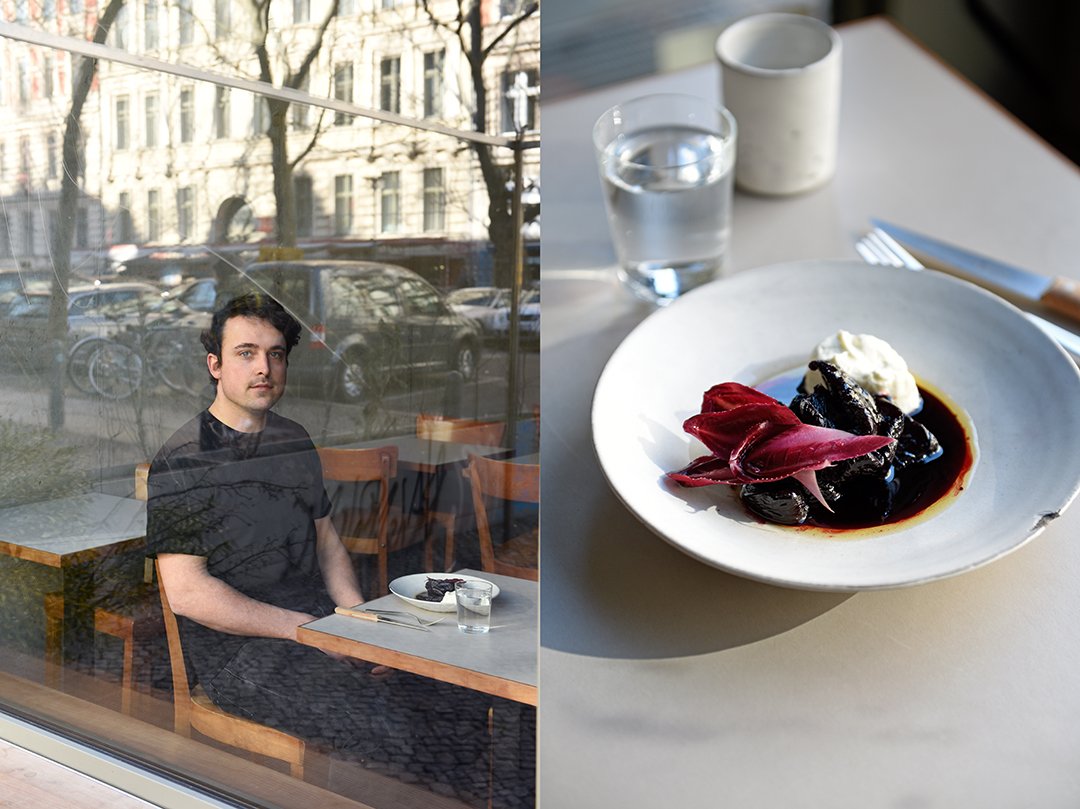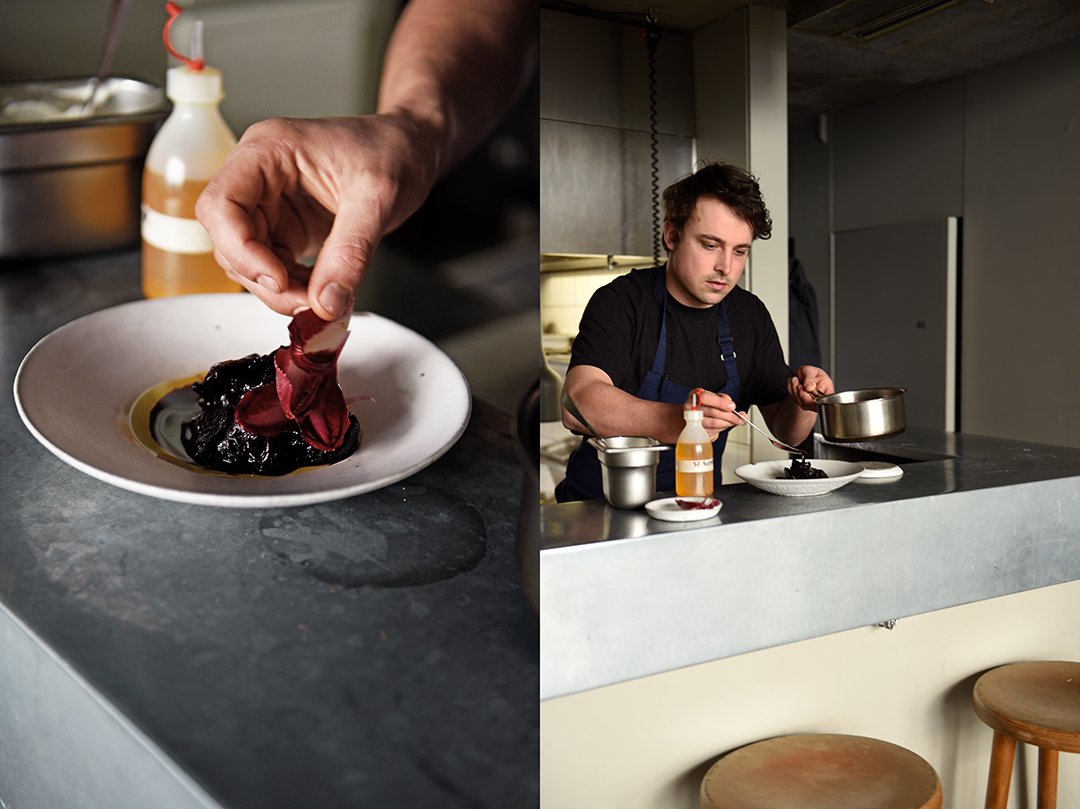Meet In Your Kitchen | Berlin's Best Beet at Vadim's Otto
This post is part of my Meet in My Kitchen podcast: How did we get to where we are in life & what does food have to do with it
"That was probably the most intense time of my life. It was the restaurant I looked up to the most. I thought this is the best restaurant in the world." - Vadim Otto Ursus
Smoky pans and blazing fire at Noma's Pop Up in Tulum, screaming and rushing, the air filled with adrenalin like a ballon ready to burst, tweezers in your hand to arrange plates to fragile perfection - Vadim Otto Ursus wanted to experience all of this and he got it. Born in Berlin, raised in Berlin, and he even returned to his city although he had the chance to keep working at Noma and other illustrious restaurants.
Vadim's parents lived in a squat in Berlin Mitte, one of the many empty houses in the 90s that people just moved into, put a lock on the door, and called it their home. It was common, no one cared. You payed one D-Mark, symbolically. There was no heating or warm water but lots of freedom and all the possibilities in the world. Vadim's mother is an artist, his father is a media historian, the wall had just fallen, and they decided to move to Berlin. Galleries popped up all around their apartment, there were exhibitions at every street corner - and young Vadim was right in the middle of it.
"You did the same thing most of the time, just when everything worked smoothly, the chef, René Redzepi, would say OK, change positions! to keep the adrenalin level at 120% so that you wouldn’t rest but always be pushed to maximum pressure." - Vadim Otto Ursus
Before he even had a chance to get lost in Berlin's party world, which he loved and that was equally exciting at that time as the art world, his mother involved him in her art projects and his father introduced him to a little restaurant on Schönhauser Allee. A bunch of young chefs, pioneers in Berlin's - at that point - culinarily wild and not very refined East, sparked something in Vadim. After having been surrounded by the arts, boundless creativity and freedom, he was hungry for a life that was a bit more structured, where cause and effect were a bit more predictable; less interpretation, more facts. Cooking is a craft, you cut your ingredients, you choose a technique, you improve your skills, and at one point you can pretty much say what the result is going to be like. Vadim liked that idea.
For an art project, the mother-son duo went on a trip to Mexico together. For two months, Vadim cooked in a food truck at a market in Mexico City and his mother curated a flow of people from different backgrounds bringing ingredients to the truck, or just their stories, all of them coming together at the table for lunch. Working with local produce, working with fire, using techniques he had learned in Germany, the puzzle slowly started to come together.
"The plates, the dishes were delicious and looked almost perfect but I don’t understand how anything good should come out if it was created with so much hate, anger, and fear."- Vadim Otto Ursus
The freedom and harmony that had surrounded him all his life was something the young chef never took for granted. He was curious about the other side where chefs scream in steaming kitchens, where pots are flying, and single leaves are meticulously arranged with tweezers for hours. So he ended up at Quintonil, no. 27 in the World's 50 Best, and just at that time René Redzepi and his team visited Quintonil's kitchen right before their Noma Pop Up started in Tulum. Coincidence or destiny, Vadim joined their team and cooked at the world's most famous Pop Up. Vadim calls it one of the most intense experiences of his life, teaching him bold techniques and wild freedom in cooking he had never seen before, but also introducing him to a way of working that he didn't want to assimilate in his life.
Koks on the Faroe Islands, Maaemo in Oslo, Loco in Lisbon, Vadim got his fair amount of Michelin stars, flying pots, and tweezers - and he missed Berlin. In 2019, at the age of 25, he opened his own restaurant close to where he grew up, in Prenzlauer Berg: OTTO. The ingredients are local, the techniques are international, the atmosphere is very relaxed, and community - on both sides of the kitchen - is at the core of this restaurant. Various plates to share with each other fill the tables, honest fireworks, almost humble and not pretentious, convince your palate within split seconds that the best often lies very close to us.
"I knew it before I went there but Mexico made it so clear to me: eating together, plates often placed in the middle of the table, huge piles of tortillas, using your hands, it can get messy, it’s spicy, bold flavors, that’s so much fun!"- Vadim Otto Ursus
And what does Otto taste like? The smokey, earthy note of a whole grilled butterflied boneless brook trout from a local farmer served with garum - a fermented fish sauce made at the restaurant of the fish's leftover bones and fins. This dish combines strong flavors from two culinary worlds: earthy local German trout and a fish sauce packed with umami, originated in Asia but made from a very common German fish.
Beet, cooked twice in sloe berry juice and dried in between, with a unique texture close to prunes meets labneh and brown butter (this is also the recipe Vadim shared with me,see below). Grilled sourdough bread from a local bakery is served with koji butter, fermented buckwheat that lends the fat a very ripe, cheesy note and that you can also buy from them online. Grilled kale is tossed with a green salsa made of herbs that Vadim harvests in the countryside outside Berlin. So what do we learn? Traveling and experiencing the world outside of our box doesn't detach us from ourselves, from our roots, it refines who we are and makes the bond even closer.
The podcast episode with Vadim Otto Ursus is in German. You can listen to the Meet in My Kitchen podcast on all common podcast platforms; there are English and German episodes. You can find all the blog posts about these podcast episodes including my guests’ recipes here on the blog under Meet in Your Kitchen.
Listen to the podcast episode with Vadim on:
Spotify / Apple / Deezer / Google / Amazon / Podimo
On Instagram you can follow the podcast @meetinmykitchenpodcast!
Beet, Sloe Berry, Labneh and Brown Butter
by Vadim Otto Ursus
Mind that you have to start preparing the beet and labneh a day in advance. The beet is cooked then it sits overnight, is dried in the oven for 7-8 hours the next day, and then briefly warmed up in the juice again.
Serves 4 to 6
1kg / 2 1/4 pounds medium beet (with skin)
Fine sea salt
1l / 4 1/4 cups sloe berry juice - alternatively, you can use700ml / 3 cups plum juice mixed with 200ml / 3/4 cup plus 2 tablespoons water, 100ml / 1/3 cup plus 1 tablespoon cider vinegar
500g / 17 1/2 ounces full-fat yoghurt (cow milk or sheep milk)
100g / 1/3 cup plus 1 1/2 tablespoons unsalted butter
A few leaves of Belgian endive, radicchio, or sorrel, torn into bite size pieces, for serving
Day 1
Add the beet to a large pot and cover with water then add 3 tablespoons of salt and bring to a boil. Cook for about 50 minutes or until tender. Transfer the beet to a colander placed in the sink and, while you keep the water running, use your hands to rub the skin off the beets. Cut each beet into 6 wedges and transfer to a large bowl then mix the sloe berry juice with 2 tablespoons of salt and pour over the beet. Cover the bowl with a lid and let it sit overnight at room temperature.
To make the labneh, line a colander with a cotton kitchen towel or muslin cloth then place it over a large, deep plate. Mix the yoghurt with 1 tablespoon of salt and transfer to the lined colander; let it sit overnight at room temperature.
Day 2
In the morning, preheat the oven to 70°C / 155°F. Line 1-2 baking sheets with baking paper.
Transfer the strained yoghurt to a bowl and keep it in the fridge, discard the liquid. Remove it from the fridge and keep it at room temperature about 30 minutes before serving.
Reserving the juice, transfer the beet to a colander to drain for a few minutes then spread them on the prepared baking sheet(s). Leaving the oven door slightly ajar by using the stick of a wooden spoon, dry the beet in the oven for 7-8 hours, or until they resemble soft (and not too dry) prunes. Season the reserved sloe juice with a little salt and set aside.
Just before serving, slowly cook the butter in a large pan over medium heat until it is golden brown and smells nutty (it shouldn't burn!); set aside and keep warm.
Transfer the dried beet to a large pot, add enough of the reserved sloe juice so that the beet is almost covered then bring to a boil and immediately remove the pot from the heat.
Arrange some of the beet and a little of the sloe juice that it's been warmed up in, in the middle of a deep plate. Drizzle with a couple spoons of the brown butter and place a generous dollop of the labneh next to the beet. Arrange a few pieces of Belgian endive (or other leaves) on top and serve immediately.














